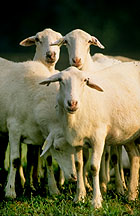This page has been archived and is being provided for reference purposes only. The page is no longer being updated, and therefore, links on the page may be invalid.
|
|
Copper Oxide Effective Against Nematodes in Small Ruminants
By Jim CoreNovember 18, 2004
Using copper oxide wire particles to control internal parasites in small ruminants, such as sheep and goats, is safe and effective when two grams or less are used.
That’s according to a study by the Agricultural Research Service (ARS), Louisiana State University (LSU), Fort Valley State University in Georgia, and other participants in the Southern Consortium for Small Ruminant Parasite Control. The researchers are studying alternatives to conventional treatments for nematode infections because of growing parasite resistance to chemical de- wormers.
Joan M. Burke, an animal scientist with the ARS Dale Bumpers Small Farm Research Center in Booneville, Ark., wants to determine optimal strategies to reduce nematode infection in sheep and goats. Copper oxide wire particles are used overseas in sheep and goats to alleviate mineral deficiencies, but that problem doesn’t exist here. However, the researchers theorized that copper supplements could improve the immune system, creating a less desirable environment for parasites.
Burke and cooperators used copper wire to find the optimal doses for controlling infections of Haemonchus contortus, commonly called barber pole worm, in hair sheep. The treatments must be restricted in order to avoid copper toxicity. They found no signs of copper toxicity at any dose tested (up to 6 grams).
Burke’s colleague James E. Miller, a veterinarian at LSU, recently found success with as little as one-half gram of wire particles for at least a four-week period, resulting in a 60 to 90 percent nematode reduction. Such a small dosage may allow more frequent treatments, especially during the infestation season.
The USDA Cooperative State Research, Education, and Extension Service’s Sustainable Agriculture Research and Education (SARE) program provided partial funding for this research.
According to Burke, future studies will include doses of two grams or less. In the meantime, producers should consult a veterinarian for de-worming advice.
ARS is the U.S. Department of Agriculture’s chief scientific research agency.

